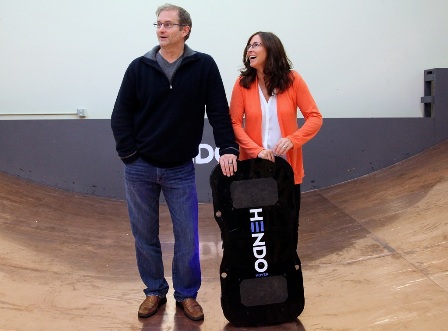Categories: Featured Articles » Interesting Facts
Number of views: 12,782
Comments on the article: 3
Flying Skateboards - Skateboard Magnetic Suspension Technology
Everyone who watched the Back to the Future trilogy probably remembers how Marty McFly escaped the chase on a hoverboard soaring. To this day, the idea of recreating a hoverboard excites the minds of many inventors - enthusiasts. Even Lexus did not neglect this idea. However, not only Lexus achieved their goal on the path of translating this fantastic vehicle into reality, but first things first.

At the end of 2014, after successfully collecting $ 500,000 on kickstarter, Greg and Jill Hendersons realized their plan. By creating Arx Pax, the couple finally built the first hoverboard in the world they named Hendo Hover.
The skateboard hover technology is based on the repulsion of magnetic fields, which creates a counteraction to the force of gravity. Soar around the same magnetic cushion trains, the only difference is that the Hendo Hoverbord can move in several directions, and not just along the rails, like a train.

Hendo's secret is exactly how magnetic repulsion occurs. Four electromagnets are located inside the device, the magnetic fields of which are continuously alternating.
When the switched-on hoverboard is placed over a copper surface, say, over a copper floor, an eddy current is induced in it, the magnetic field of which, in turn, repels electromagnets according to the Lenz law. So there is a lifting force capable of holding a floating board 2.5 centimeters above the surface of the conductive floor.

The author of the development, Greg Henderson, said that as an architect, he approached the design creatively, and immediately began to think about how to organize the interaction of the fields so that it would not be necessary to use powerful magnets. He decided that it was just to make the magnetic flux work more efficiently, then powerful magnets would not be required.
He began to ponder how magnetic cushion trains move, and imagined a long magnetic cushion train moving in a ring. If the primary magnetic field itself creates a secondary magnetic field, then repulsion no longer requires a magnetic field, just a copper floor to induce eddy currents.

Tony Havk himself tried the Hendo hoverboard, noting that it is incomparable with either a skateboard or a snowboard, but why not ride a hoverboard.
Meanwhile, the creator of the floating board, Greg Henderson, noted that in principle it is possible not only to keep the hoverboard above the surface of the conductive floor in a stable state, but even to improve the process. By adjusting the strength of the induced field, it is possible to initiate the board sliding forward. However, even the very first Hendo models were quickly sold at $ 10,000 apiece.

Despite the fact that the project was developed for almost two years by a group of 19 people, the first version of the product made a lot of noise, because there were always moving parts inside, and after every seven minutes the board was recharged, recharging was required. However, the creators are constantly improving their brainchild, and in the immediate plans of the creators is the introduction of the ability to control the movement of the hoverboard from a smartphone.
As noted at the beginning, Hendo is not the only successful implementation of a hoverboard. So, in the summer of 2015, Lexus introduced their levitating skateboard, dubbed "Slide". A subsidiary of Japanese Toyota Motors has long been thinking about how to make cars more perfect, and a hovering car is by no means an idle fantasy, but they decided to start with a hovering skateboard.

Principle magnetic levitationimplemented in Slide is different from Hendo. It uses liquid nitrogen cooled superconductorthrough which direct current is passed.The magnetic field created by this current interacts with the magnetic field of the permanent magnets built into the track, so a repulsive force arises that can hold the skateboard together with the skateboarder soaring in the air 5 centimeters above the track surface.
Obviously, this also has some difference from the principle of suspending trains on a magnetic cushion, where just two strong electromagnets interact, starting from each other.

To keep the conductors inside the hoverboard in a superconducting state, Lexus used liquid nitrogen, and fog is visible in the demonstrations - this is condensation that occurs in the air when it interacts with liquid nitrogen. Nitrogen cools the conductive ceramic tiles from yttrium, barium, copper and oxygen to -180 ° C, so the magnetic field of the superconductor is quite strong.

The board itself weighs 9 kilograms, and is slightly thicker than an ordinary skateboard. Professional skateboarder Ross Mac Gowran during these comprehensive test demonstrations in Barcelona noted these features. He said that the ride effect surprised him because there was virtually no friction.
A 200 meter long magnetic track, for testing Slide hoverboards, was specially made in Dresden (Germany), and then transported to Barcelona, where the "hoverpark" was built - a test track. The track looks like it is completely concrete, but it is not.
The skate park is made of plywood covered with a thin layer of concrete, under which are the magnets that form the magnetic track, and only on this track can you move on a hoverboard, hovering at a height of 5 centimeters for 20 minutes or less, depending on the weight of the skateboarder. While the liquid nitrogen is sufficiently cooled, the hoverboard can soar, and there is enough magnetic force even for the skateboarder to jump on the board.

Of course, the Lexus solution is tied to the magnetized track of the skate park, which everyone will not be able to access, and this makes the toy useless. Nevertheless, this is the first case in the world when a serious company has built a hoverboard, applicable only in specific places.
See also at electro-en.tomathouse.com
:
